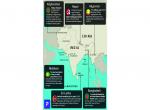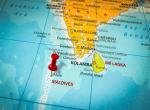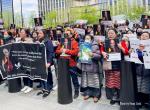In this month’s compilation of some of the big ideas being debated in the media across the Indian sub-continent, we look at some big ticket items on the diplomacy and national security fronts - for Bangladesh, the focus is on Prime Minister Sheikh Hasina’s outgoing India tour; for Nepal, it is Chinese President Xi Jinping’s once-in-a-generation incoming visit to Kathmandu. In Sri Lanka, the spotlight was back on the Easter Sunday terror attack, as a parliamentary panel completed its investigation and submitted its report to Parliament. The attack shook the Colombo establishment, and its aftermath continues to be closely monitored by security analysts worldwide. Finally, the set closes on a soft and positive note - highlighting how the finalisation of the Kartarpur corridor that would allow Indian Sikhs to access their holy places in Pakistan, is being cheered across the border.
Bangladesh: An equal Partnership with India?
In early October, Bangladesh Prime Minister Sheikh Hasina visited Delhi on a four-day official tour. In the run up to the visit, The Dhaka Tribune noted in its editorial that, “For Bangladesh, staying on the path to sustainable development involves fostering a strong partnership with neighbouring India” and that the Prime Minister’s current visit was an “example of the sort of diplomacy required to ensure Bangladesh’s position in the world, and to ensure that our citizens are provided for.”
After the visit, Bangladeshi analysts commentators highlighted two key issues. First was regarding river water sharing. Writing in the Daily Star, economist Nazrul Islam noted, that the agreements catered to “the interests of India” while “there was hardly any concrete progress toward meeting Bangladesh’s concerns (regarding Teesta river and the Farakka barrage issues).” In this context, Islam also added that, “It is ironic that the only concrete river-related outcome of the Hasina-Modi meeting was Bangladesh’s agreement to allow India to withdraw part of the Feni River flow. The quantity is small, but the symbolism is large. It shows that, as far as shared rivers are concerned, India gets what it wants while Bangladesh keeps on pleading”.
The second issue that came under scrutiny was the bilateral agreement on India setting up a surveillance radar system along Bangladesh’s coast. Former Foreign Secretary of Bangladesh Md Touhid Hossain raised four questions about this agreement. Writing for Prothom Alo, he asked: “1) Who will own these installations, India or Bangladesh?; 2) Bangladesh has no military bloc or alliance with India, so how can there be Indian military installations on Bangladesh’s territory?; 3) If the ownership is of Bangladesh, then who will control the software being used and the information that will be collected?; 4) If China’s presence in the Bay of Bengal is under surveillance and if India receives this information in real time, will this not be considered a programme hostile to China?, What will then happen to efforts to maintain a balance between India and China in our foreign policy?”
Sri Lanka: the Politicisation of a Terror Investigation?
On October 26, the Parliamentary Select Committee (PSC) that had been investigating the Easter Sunday terror attacks submitted its report to the Sri Lankan parliament. The report was the first official account of the attack, and sought to answer many of the questions that were raised in its aftermath. Writing for the Sunday Times, columnist Neville de Silva noted that “It was a damning report by all accounts” which placed blame at the doorsteps of the security establishment as well as the political class. Indeed, de Silva writes, “the most interesting and important observation the Select Committee makes relates to any nexus between state officials and politicians … that further investigations will be needed to understand whether those with vested interests did not act on intelligence so as to create chaos and instill fear and uncertainty in the country in the lead up to the presidential election to be held later in the year… such a situation would then lead to the call for a change of regime to contain such acts of terrorism. Coincidently or not so coincidentally, the security situation and fear would be unleashed months away from the presidential election.”
Adding another aspect to this debate, Kalinga Tudor Silva wrote in the Colombo Telegraph that “the PSC report is not entirely free of politicising national security issues and engaging in the blame game rather”. Silva noted that the “PSC only represented some political parties”; key players like “the SLPP and SLFP opted out of the PSC both in terms of composition and deliberations”; “In a cabinet meeting President Maithripala Sirisena wanted PSC hearings stopped, describing it as a personal witch hunt against him”; and that “throughout the period from May to September opposition parties and the President himself tried to discredit and obstruct the working of PSC”. As a result, Silva argues that the “PSC is unlikely to be seen as a credible account by some key actors in the political spectrum in Sri Lanka”.
Nepal: What is the cost of Kathmandu’s Democratic Values?
On October 11, Chinese President Xi Jinping arrived in Kathmandu for a two-day state visit. This was a landmark visit because it was the first by a Chinese president since 1996 and naturally carried enormous geo-political and strategic significance. The political class in Kathmandu, of course, laid out the red carpet for the visiting dignitary but the commentariat took care to underline existing concerns and potential challenges. For example, the Kathmandu Post noted in its editorial that though “Nepal has done little to displease its large northern neighbour…. little of what was promised (by China) has materialised. None of the nine projects identified under the Belt and Road Initiative has moved forward…”
The editorial also drew attention to the mutual extradition treaty that is under consideration and noted in no uncertain terms that the “treaty is aimed squarely towards Tibetan refugees” and might soon lead to a situation wherein Nepal may have to decide “whether Chinese aid is worth compromising on fundamental democratic values”. The Nepali Times also highlighted the same issue in its own editorial, noting that “the agreement is obviously targeted at the 15,000 Tibetan residents and refugees in Nepal”, and that “It is not lost on anyone that the protests in Hong Kong this year were sparked off by a similar attempt at extradition”. The newspaper also said that Nepal should focus on in itself, and if anything, follow China’s example of self-reliance, instead of getting caught in the crosshairs of its two large neighbours.
Pakistan: Strengthening People-to-People Ties with India?
In the last week of October, India and Pakistan signed the Kartarpur Agreement that allows Indian Sikhs to cross into Pakistan and travel to the revered Dera Baba Nanak in Narowal district, without a visa. The development came even as Pakistan continued to criticise India’s decisions in Kashmir and seems to have lit a spark of positivity in the bilateral. The Express Tribune hoped in its editorial that the corridor would “create a ground to remove further barriers that exist between the two countries and return to a time when people identifying themselves of different faiths and nations coexisted peacefully”. On similar lines, the Dawn editorial also noted that if the Kartarpur Corridor is a success, it could boost religious tourism between the two countries. “Some of the most revered Sikh shrines are located in Pakistan… There are also some ancient sites sacred to the Hindu community, such as Katas Raj, which can feature prominently on the religious tourism trail. Similarly, some of the subcontinent’s most revered Sufi saints’ tombs are located in India, such as that of Khawaja Moinuddin Chishty in Ajmer, and Nizamuddin Auliya in Delhi. Countless followers of these revered individuals in Pakistan would be delighted to visit their dargahs if the visa regime were made less stringent,” the newspaper noted in its editorial.
(The paper is the author’s individual scholastic articulation. The author certifies that the article/paper is original in content, unpublished and it has not been submitted for publication/web upload elsewhere, and that the facts and figures quoted are duly referenced, as needed, and are believed to be correct). (The paper does not necessarily represent the organisational stance... More >>
Image Source: http://www.indiandefencereview.com/wp-content/uploads/2018/11/Kartarpur-Corridor.jpg

_0_0_0_0.jpg)








Post new comment